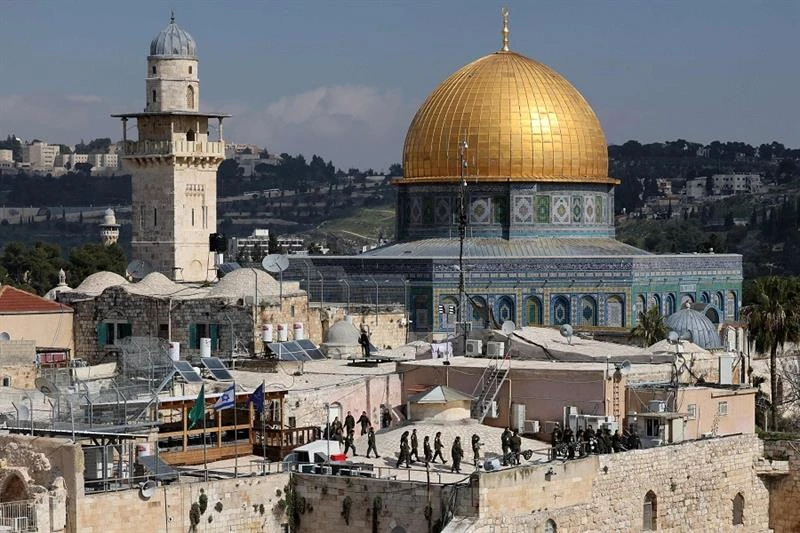The value of Al-Aqsa Makkah concerning spirituality and history is not only for Muslims alone but for all the world, taking Jerusalem the Temple Mount heart, where lies the third holiest site in Islam, after Mecca and Medina. This mosque, as a place where he believed Prophet Muhammad ascended to heaven during the Isra and Mi'raj journey, made it the foci of Islamic devotion and history. However, besides its religious importance, Al-Aqsa represents a touchstone of the mixed and varied cultural and religious heritage of Jerusalem, where Jews, Christians, and Muslims share parts of their histories. Stunning structures, sacred sites, and very deep ties of the built environment to this region's history, Al-Aqsa Mosque is the most vital place of worship, reflection, and pilgrimage, attracting millions of visitors and pilgrims from across the world each year. through a Holy Land Day Tour so that it can discover the mosque alongside other sacred landmarks in Jerusalem.
The Importance of Al-Aqsa Mosque in Islam
A Sacred Site for Muslims:
Al-Aqsa Mosque is an important symbol of faith and devotion. According to Islamic tradition, this is the place where the Prophet Muhammad made his Isra and Mi'raj, a miraculous night journey and ascension to the heavens. The journey, as narrated in the Qur'an and the Hadiths, started at the Kaaba in Mecca and ended at Al-Aqsa Mosque, from where the Prophet Muhammad ascended to the heavens, confronted past prophets, and received divine instructions from Allah.
Direction of Prayer or Qibla
Al-Aqsa Mosque has also had its early place in the Islamic history of worship. During the early Islam, Muslims prayed towards Jerusalem, specifically Al-Aqsa. This direction was called Qibla, which was later changed to Mecca through divine command. Nevertheless, there remained in the Muslim community a profound reverence for Jerusalem and Al-Aqsa, thus giving more spiritual messages regarding mosques in Islam.
Symbol of Unity and Devotion
For Muslims, making a pilgrimage to Al-Aqsa is a very deep act. Another factor that makes Al-Aqsa prayers very holy is that it has been on the top list of places to visit by those performing the pilgrimage (Hajj) in Mecca.Not that it is obligatory like going to the pilgrimage in Mecca, but having a very high status, many Muslims wish to perform prayers at this mosque. The Hadith (sayings done by Prophet Muhammad) mentions that of this mosque when he said: "Travel not except to three mosques: Al-Masjid al-Haram, this mosque of mine, and Al-Masjid an-Nabawi."
A Place of Peace
Al-Aqsa Mosque is not a physical edifice but an embodiment of peacefulness, devotion, and submission to the Almighty in Islam. This mosque could be a center of devotion; a school; or a place of community getting-together. Over time, it has been a space associated with prayers for Muslims, and its calmness has been an ambiance of reflection, devotion, and connection to Allah.Of its many deep Islamic heritage holdings and roots, it has become something that millions of Muslims connect as faith: the oneness of the entire global ummah.
Political and cultural significance:
Al-Aqsa Mosque Religious Importance is Important, but it is also Political, Cultural, and Significantly Valuable for Many Palestinians. The whole area of the Al-Aqsa Mosque is interpreted as a manifestation of Palestinian identity and resistance, particularly in light of Israeli-Palestinian conflict. The Mosque is a symbolic one in terms of the struggle for religious, cultural, and political rights in Jerusalem. Muslims everywhere are rallying around this identity and advocating preserving it and access for worshippers.
Architectural Wonders: Exploring the Beauty of Al-Aqsa Mosque
Dome of the Shrine of Al-Aqsa Mosque
Quite majestic like its calling, the dome is one of its prominent features, enjoying being the most outstanding characteristic of Islamic artistry. In contrast to the sparkling golden dome of the Dome of the Rock, the dome of the Al-Aqsa Mosque is a deep, vibrant gray that has been characteristic for centuries. The structure of the dome and surrounding courtyards and arcades contributes to the overall impression of the mosque as grand and peaceful. Here again, symmetry and balance are emphasized—the familiar themes of Islamic architecture—which represent the perfection of the divine order.
Courtyards and Arcades
As much as the large courtyards form a major part of the architectural composition of the mosque, they also serve as major elements for its features in architecture. Another courtyard having access from the Al-Aqsa compound is the underground al-Marwani Mosque. The arcades stride into this space from their surrounding courtyards and make all remain secluded and cool places for worshippers. The pillars are richly ornamented with geometric patterns and delicate arches to point to the cultural and historical integration of Islamic art with that of the region.
The Prayer Hall and Interior Design
The internal structure of the Al-Aqsa Mosque evidently shows an imprint of tranquillity, being simple and elegant in design. The prayer hall has a capacity for thousands of worshippers, with very high vaulted ceilings and elaborate mosaics on walls. Islamic calligraphy has been used, along with geometric patterns on walls and ceilings, creating a visually beautiful environment that encourages spiritual reflection. The floors of the mosque are typically covered with carpets, which provide a comfortable area for congregating and praying.
The Dome of the Rock and Its Relation with Al-Aqsa
Dome of the Rock is not precisely a mosque; yet, it shares common sacred ground and is integral to the divine beauty of the Al-Aqsa Compound architecturally. "Because quite apart from the mosaic tiles and gold of the Holy Sanctuary, all the extra features and majesty of the Al-Aqsa Mosque just create and provide a striking and melodious, profound experience or complex.
Historical layers and cultural influences:
The architectural beauty of Al-Aqsa Mosques attests. However, its repetition of renovations and extensions years ago came from several dynasties of Muslims ranging from the Umayyads, Abbasids, Fatimids, Ayyubids, and Ottomans. Each of the periods brought to architecture boldly mingling germination in features of traditional Islamic architecture and influences from the Byzantine and Crusader styles. This fusion creates for itself a unique eternal piece in terms of architecture.
The Minarets and Outer Walls
The mosque has four minarets that serve as a well-known component of its architecture. Thin towers rise above the mosque, serving a dual function—as ornamentation and functional. The minarets stand proportionate and provide verticality under the horizontal configuration of the mosque-awe for the newly approaching site. The outer walls of the great mosque consist of pale stones that have weathered over centuries, giving the structure an impression of enduring time. Such stonework is finely detailed, with carvings and decorative elements that speak for the high skills possessed by the artisans who built it.
Visiting Al-Aqsa Mosque: A Guide for Pilgrims and Tourists
Understanding the Importance of Al-Aqsa Mosque
Before visiting Al-Aqsa, one ought to understand its very profound religious importance. The Al-Aqsa is the third holiest site in Islam after Mecca and Medina. It is primarily linked to the miraculous journey taken by the Prophet Muhammad known as Isra and Mi'raj. In addition to its worth in terms of religion, it represents the city of Jerusalem as one city in which faith is shared within the far-reaching ties of Judaism and Christianity.
Opening Hours and Accessibility
Al-Aqsa Mosque is practically open to Muslims on a daily basis at prayer times, but visits to the mosque must be in line with prayer times and visiting hours. Non-Muslim tourists are allowed to visit the mosque, but will normally be allowed entry for specific hours and may find visiting further restricted according to the security or political status in the region. Fridays can be particularly popular for prayers, so if you want to avoid the crowds, visit on other days.
Dress Code and Behavior
Modest attire is a form of showing respect while visiting Al-Aqsa Mosque. Therefore, visitors must come dressed appropriately. It is best that a man wears a long-sleeved shirt or t-shirt and long pants, while a woman should wear either a long skirt or pants and a head covering since her arms need to be covered. Maintain salutary behavior within the precincts and, above all, obey the mosque's rules and its customs. Remaining quiet in the confines of the mosque and never interfering with the prayers or echoes in the ambiance should be another guideline for visitors.
Visiting a sacred buildingAl-Aqsa Mosque forms part of a greater whole, the Al-Aqsa Compound (Haram al-Sharif component), which comprises some of the finest religious edifices, including the Dome of the Rock and the al-Marwani Mosque. The moment he crossed into the precincts, he would instantly feel saturated in an atmosphere that suits one with a sacred mood—a fine, rich atmosphere for his prayers and reflections. The mosque, with its famous dome, the minarets, the beautiful mosaic-decorated prayer hall, and its adjoining yards and arcades, contain some of the most splendid architectural features.
Security and Entrance Regulation
Though entrance is limited to all visitors, security checks are made quite seriously because of the site's importance and the politics surrounding it. In order to enter the compound, all visitors must first get clearance at the security checkpoints. There are specific rules for non-Muslim visitors, and there may be prohibitions imposed at times, according to the current political or security situation. Prior information is recommended for entry purposes.
Guided Tours and Local Insights
You can visit the Al-Aqsa Mosque on your own, yet most people like to explore the area with a guide because it would enhance their knowledge on the grandeur of the building-the fact it has been both a mosque and a synagogue. Local guides know what to tell you about the mosque's history, the role it plays in Islam, and architectural wonders. Many more education resources will help anyone wishing to learn more about the mosque and the larger Al-Aqsa compound.
The majestic and global heritage of Al-Aqsa Mosque has been significantly linked with its spiritual and historical meaning as one of the holiest places in Islam, attracting millions of visitors and worshipers every year. Beyond being a sacred Islamic site, it also serves as a strong symbol of common religious heritage, bringing Judaism, Christianity, and Islam closer. It is within this heritage site, at the famous Al-Aqsa Compound in Jerusalem, that the centuries of historical, cultural, and architectural development manifest, making it a state of pilgrimage and travel from around the world within Holy Land packages. Al-Aqsa Mosque's immortal beauty and experience, as well as its symbolic importance in the Holy Land, will, therefore, seed future generations and borders with awe, oneness, and reflection.


--webp.webp)



-webp.webp)


